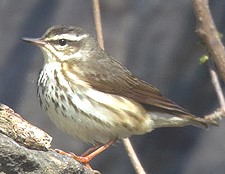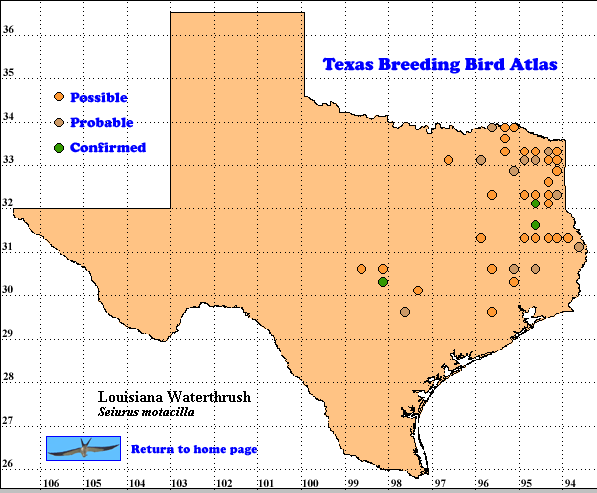Louisiana Waterthrush, like the other two members of its genus, Northern Waterthrush (S. noveboracensis) and Ovenbird (S. aurocapillus) are terrestrial foragers. The two waterthrushes are most often seen walking along the edges of ,streams, lakes or swamps in shaded deciduous woods, while the Ovenbird is usually found in drier, upland woods. The terrestrial habit, unusual for wood-warblers, and preference for riparian areas, probably accounts for the name “waterthrushes.” The habit of wagging its tail up-and-down while walking, as some thrushes do, may also have contributed to its English name. Distinguishing the two waterthrushes is not easy, particularly during migration in areas such as Texas where both the Louisiana and Northern waterthrushes are present (Robinson 1995, Pyle 1997).
Louisiana Waterthrushes gather most of their prey by picking insects and other invertebrates from in or on the surface of streams while walking along the edge. They have also been observed hovering over the water to pick insects from the surface or from vegetation, and hawking for flying insects (Robinson 1995).
DISTRIBUTION. During the 1987-1992 field work seasons of the TBBA project, observers found 4 confirmed breeding records (latilong-quads 30098-C2, 31094-E6 & F6 and, 32094-A5). Twelve probable records were within the area bounded by meridians 29 and 34 and parallels 93 and 98. Workers also found 40 possible records. Almost all of these records were within the Pineywoods and Post Oak Savannah and Blackland Prairies regions (see the region map in Lockwood and Freeman [2004]). In Oklahoma atlasers found breeding evidence as far west as the counties bordering the 100th meridian, although density of sites increased eastward (Gall 2004).
From Texas and Oklahoma the breeding range of this waterthrush extends north to eastern Kansas and east to the Southeast, Mid- Atlantic, New England and southern Great Lakes states. The species winters in Mexico, Central America, the West Indies and sparingly in northern Colombia and Venezuela (Robinson 1995, Sauer et al. 2005)
SEASONAL OCCURRENCE. Most migrant Louisiana Waterthrushes appear in Texas between mid-March and late April as uncommon migrants in the eastern two-thirds of the state. The breeding season extends from mi-April to mid-July, based on egg dates from April 22 to June 13. Most southbound migrants depart between early August and mi-September (Oberholser 1974, Lockwood and Freeman 2004).
BREEDING HABITAT. Louisiana Water- thrushes breed in Texas between 23 and 300 m (75-1000 ft) elevation in riparian thickets within large woodland tracts (Oberholser 1974). The presence of running water is apparently strongly preferred. The nests are most often found among the roots of an upturned stream-side tree or under a fallen log; in these locations the structure is usually concealed from above/. Both sexes work on building the bowl from dead leaves and plant stems gathered from stream edges. The insulated structure is reinforced with twigs and held together with mud. Within this shell an inner cup is built of fine plant stems, rootlets moss and hair. The outside diameter averages 15 cm (6 in), the inside diameter averages 7.5 cm (3 in)_and the cup depth is between 4-5 cm (1.6-2 in; Harrison 1979, Robinson 1995).
In the cup the female usually lays 5 (range 3-6 ) smooth, white eggs, speckled, spotted or blotched with reddish brown, often concentrated at the large end. The female incubates the eggs for 12-14 days and the nestling stage usually lasts 9-10 days. The adults divide the brood and stay with the young for 3-4 weeks. Only one brood is raised per year. Parasitism by Brown-headed Cowbirds (Molothrus ater) varies with location and degree of nest concealment from 33-81% (Harrison 1979, Robinson 1995).
STATUS. In Texas Louisiana Waterthrush is an uncommon summer resident in the eastern third of the state (Lockwood and Freeman 2004). The larger area of breeding and summer distribution records on Oberholser’s (1974) map than on the TBBA map strongly suggests a range reduction for this waterthrush has occurred in Texas in historic times. North American Breeding Bird Survey data for this species in Texas are derived from only 4 routes; observers detected a maximum of 1-3 individuals per year on any route (Sauer et al. 2005). This is not adequate to produce biologically significant trend data. Although the range-wide trend suggests little population change, the apparent range reduction in Texas suggests further habitat loss could eliminate Louisiana Waterthrush as a breeding species in Texas. Text by Robert C. Tweit (2007)
Harrison, H. H. 1979. A field guide to western birds’ nests. Houghton Mifflin, Boston, MA.
Sauer, J. R., J. E. Hines, and J. Fallon. 2005. The North American Breeding Bird Survey, results and analysis 1966-2005. Version 6.2 2006. USGS Patuxent Wildlife Research Center, Laurel MD < http://www.mbr-pwrc.usgs.gov/bbs>

